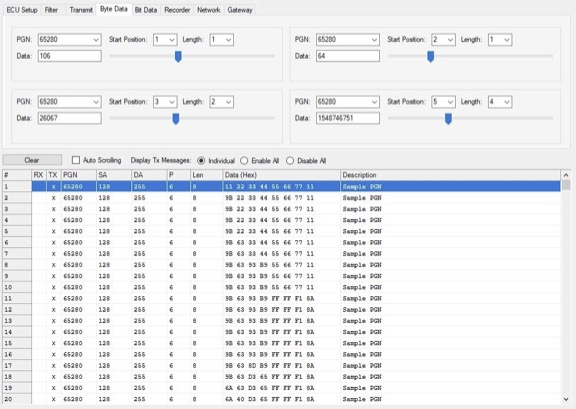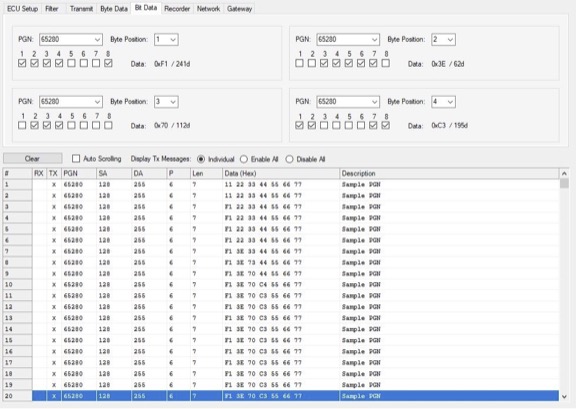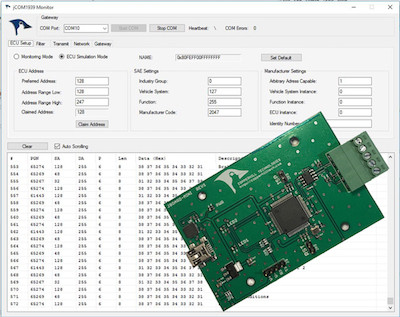Recent Posts
SAE J1939: Simulation of Analog and Digital Signals with the JCOM1939 Monitor Software
Posted by on
The JCOM1939 Monitor Software is ideal for monitoring, recording, analyzing, and simulating SAE J1939 data traffic. The system works in combination with our SAE J1939 gateways.
This comprehensive and easy-to-use, easy-to-understand Windows software displays not only SAE J1939 data traffic but also scans the network, simulates an ECU (incl. full node address negotiation features), and responds to data request messages.
The communication protocol between the gateway and the host system (PC, Embedded System, Android System, etc.) is well documented, and we provide C/C# source code to read and write CAN data frames.
Features
- FREE download
- ECU Simulation Setup (Preferred Node Address, Negotiable Address Range, NAME, and more)
- Filter J1939 PGNs for Display
- Design J1939 PGNs for Transmission (Data and Request Messages)
- Design J1939 PGNs for Request Responses
- Simulate Digital and Analog Signals
- Scan a J1939 Network (Number of Nodes, Node IDs, NAMEs)
- Record SAE J1939 Data Traffic
- Simulate SAE J1939 Data Traffic
- Check Gateway Status (Error Messages, Software/Hardware Version)
- Set Gateway Parameters (Heartbeat Frequency, Message Acknowledgment)
- Free Updates
SAE J1939 Gateways
The JCOM1939 Monitor software versions work directly with the following SAE J1939 gateways:
- SAE J1939 ECU Simulator Board with USB Port...
- JCOM.J1939 Starter Kit and Network Simulator...
- SAE J1939 to Bluetooth Gateway...
- SAE J1939 to RS232 & USB Gateway...
In this post, we explain one of the many features:
Simulation of Analog and Digital Signal PGNs
As of version 3.20.00, we have added two sections to the software that allows the comfortable editing of selected data bits and bytes, resembling digital and analog signals:
Byte Data Editing - Simulation of Analog Signals
In the Byte Data section of the jCOM1939Monitor software, the user can select a previously designed PGN, the data start position, and the data length (1, 2, 3, or 4 bytes). The program will display the data as selected and allow the user to modify the data either per text input or by sliding the associated track bar.

In the Byte Data section of the jCOM1939Monitor software, the user can select a previously designed PGN, the data start position, and the data length (1, 2, 3, or 4 bytes). The program will display the data as selected and allow the user to modify the data either per text input or by sliding the associated track bar.
This mode was specifically designed with the simulation of analog signals in mind. However, due to the generic nature of the software, it does not verify that the selected PGN data represents an analog parameter. In the above sample, we chose a random selection of proprietary PGNs, and while the screen shows four different PGNs, the program also allows the simultaneous modification of several bytes in the PGN data field.
The following screenshot demonstrates how several bytes in one PGN were modified:

Note that the data is being updated and transmitted as soon as it is modified by the user.
Bit Data Editing - Simulation of Digital Signals
The Bit Data section was designed to modify digital signals. It functions similarly to the Byte Data section but is limited to one byte. Also, the program uses check boxes instead of a slider to set or reset digital information.

The following screenshot demonstrates how several bits in one PGN were modified:

Download the full manual here.
SAE J1939 to USB Gateway in Plastic Enclosure
The SAE J1939 to USB Gateway utilizes our SAE J1939 ECU Simulator Board with USB Port and embeds it in an enclosure. The SAE J1939 gateway allows you to monitor, simulate, and record any PGN as defined in the SAE J1939-71 Standard, and it also includes diagnostic messages according to SAE J1939-73.
The board supports the full SAE J1939 protocol according to J1939/81 Network Management (Address Claiming) and J1939/21 Transport Protocol (TP). It is also supported by an extensive programming interface for Windows and Linux/Ubuntu applications, including full C/C++/C# source code for short time-to-market developments.
 Loading... Please wait...
Loading... Please wait...


